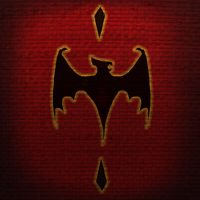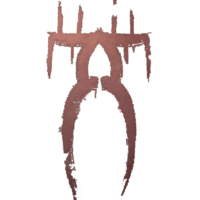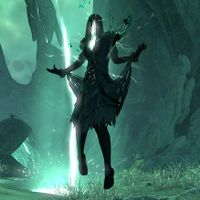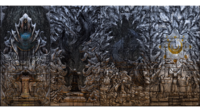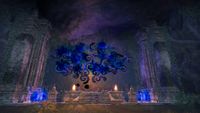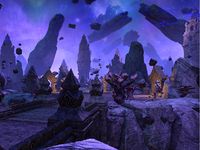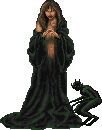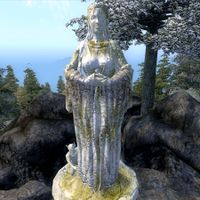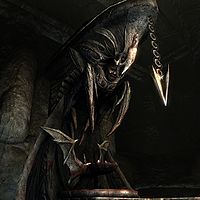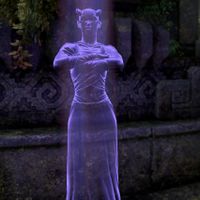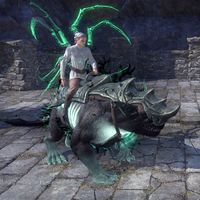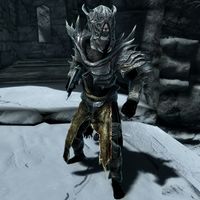Lore:Namira
| Namira | |||
|---|---|---|---|
 A statue of Namira |
|||
| Type | Daedric Prince | ||
| Realm | Scuttling Void | ||
| Pantheon | Khajiit Pantheon (The Dark Spirits) Reachfolk Pantheon (Great Spirits of the Reach) Breton Pantheon (Glenmoril Wyrd's Faith) |
||
| Spheres | Hunger, Decay, Death, Rebirth, Revulsion | ||
| Servants | Dremora, Dro-m'Athra, Shades | ||
| Appears in | |||
Namira is a Daedric Prince whose sphere is the ancient Darkness. She is also known as the Daedric Prince of Hunger,[1] the Mistress of Decay or Lady of Decay,[2][3][4]:293 the Spirit Daedra,[5] and the Goddess of the Dark.[6] Namira is the ruler of sundry dark and shadowy spirits, and is often associated with slugs, spiders, and other things that inspire mortals with instinctive revulsion.[5] The symbol of a bat is featured on her emblem. The Khajiit believe that all creatures who feed on rotten flesh are her spies.[7] She is the Daedric Prince of spirits and shadows, as well as the patron of vermin and squalor.[3] Namira also appears to be associated with beggars and the beggaring gifts of disease, pity, and disregard.[8] Namira and her shadowy endeavors are often recognized to bear some association with eternity.[9] Somewhat in line with this, the Khajiit believe that she is a spirit of infinite realms.[7] Namira sees herself as the rightful ruler of all spirits.[10] In some culture's creation stories, she is responsible for corrupting Lorkhan,[11] or making a deal with him during his endeavor to create Mundus.[12]
Mortals who become ensnared by this spirit are tortured until they forget who they were and know only Namira. Ancient Khajiit knew her as an Ur-dra,[7][11] a term also used to describe Nocturnal.[13] It implies that the owner of the title is the "eldest and most powerful of the Daedric Princes".[14] Hermaeus Mora is similarly called the Ur-Daedra[15] who is "elder than Ada".[16] Namira's followers and the priesthood of Arkay have clashed in the past.[17][18] Namira counts Azurah,[19] the Twilight Cantors,[20] Khenarthi[21] and Ebonarm among her enemies.[22] Her summoning day is Marukh's Day, the 9th of Second Seed.[23]
Namira is occasionally depicted in statuary as a long-haired woman wearing robes, typically flanked by a scrawny (occasionally humanoid) little beast.[17] Other depictions portray Namira as a cloaked figure with a slug-like body and a skeletal face and torso, with many spiny arthropod legs.[2]
Religion and Culture[edit]
Several Reachman clans pay reverence to Namira.[24] Some tribes call Namira the Children's God because she is the mistress of small pests.[6] To the Khajiit, she is known as Namiira,[25] the Great Darkness, The Eldest Spirit, and The Void.[7]
Khajiit[edit]
In Khajiit mythology, it is said that Fadomai fled from Ahnurr into the Great Darkness to birth her youngest child, Lorkhaj, and the Great Darkness filled his Heart. The Great Darkness then knew its name was Namiira.[26] When Nirni approached Lorkhaj, whom she asked to create for her children a dwelling; he did so, and yet the Great Darkness in his heart influenced him to deceive his siblings so that they were trapped in the new place with Nirni. Some managed to escape death and become the stars, and those who remained punished Lorkhaj by tearing out his heart and hiding it deep within Nirni, so that he would be with her whom he had done the most harm.[26]
Pre-ri'Datta texts state Lorkhaj survived and fled to Azurah with a wound in his chest, where she saw Namiira dwelling within as a corruption resembling a heart. Azurah cleansed Lorkhaj and flung his Dark Heart into the Void, and Lorkhaj perished within Azurah's embrace.[11] From this false heart came the twisted shade of Lorkhaj known as the Moon Beast, first of the dro-m'Athra. And so Lorkhaj represents the duality of Khajiiti souls and their susceptibility toward the spiritual corruption of the Bent Dance.[27][7] Y'ffer was corrupted by the Great Darkness sometime after Lorkhaj's death, and murdered Nirni. Hircine, Azurah and Khenarthi slew him in retaliation for the deed, then built a cairn for Nirni using his bones.[28]
Namiira is considered an enemy of the living, and is placated rather than worshiped.[29] She serves as the antithesis to Khenarthi's role for Khajiiti spirits, preventing them from reaching Llesw'er by corrupting them into dro-m'Athra via the Bent Dance, so that they may be dragged down into the Dark Behind the World. These spirits occasionally slip through the cracks in Nirni, and tempt Khajiit so their souls can be sent to the Dark to serve Namiira.[30] Giant spiders and hoarvors also tend to spill out from the Dark Behind the World in places where the Great Darkness' presence is pervasive.[31][32] An unusual increase in the presence of weevils, locusts, slugs and other bugs harmful to crops is a sign that a source of Namiira's corruption is nearby.[33]
Reachmen[edit]
Namira, (also spelled Nimeria in the ancient Reachfolk language)[34] who is known as the Spirit Queen, the Goddess of Death,[35] and the Black Fly,[36] is a revered spirit in the Reachman pantheon that represents darkness, endings, and rebirth.[37] She is seen as the sovereign of the infinite world of spirit, one of the two worlds of existence.[35] The Reachfolk creation story speaks of Lorkh having an epiphany when he visited the darkness; that which is perceived as nothingness is ripe for possibility.[38] And so, Lorkh approached Namira and convinced her to grant him a place in the infinite void to create a realm for wayward spirits, but it was not without a cost. Lorkh sacrificed himself to create a harsh realm, one that is unforgiving and intended to teach through suffering.[12] Hircine took the mantle of Lorkh's creation, becoming the sovereign the second world: the realm of flesh.[35]
Hircine and Namira's roles complement each other. While Reachfolk dwell in the world of the living, Hircine is a guide that helps them navigate Nirn's hardships.[39] Upon death, Namira acts as a psychopomp for Reachman souls that gives and takes lives, until their spirits are enlightened. Thus, Namira is seen as the avatar of primal dualisms, such as beginnings and ends, which stem from her world of spirit.[35] At the "end of all days", Hircine will fight alongside the Reachmen,[40] and Lorkh's Dark Heart will beat again, reawakened by feeding on the deaths of mortals, and its darkness will spread from its depths to consume everything, sparing only Namira's faithful.[41]
Celebrations and rituals to Namira vary per clan. The entire tribe of the Boldclaw clan participate in Namira's Dance around a large bonfire, which honors life and death. Those that dance naked represent how they are born into the world, while those who wear dark colors and paint represent death. Blood is smeared across various tribesmen during the dance.[37] Some clans may look to darker avenues to appease Namira, such as human sacrifices. Those that undergo such practices may seek to twist and abuse Namira's gifts to gain power, which when wielded, can cause great calamities.[42] This brings out dark corruptions known as "voidstuff", which can empower a clan's witch, turning them into Voidmothers (also known as Void Liches), which can consume the souls of their victims.[43] They are considered a type of Shade: dark, hateful, and hungry spirits that have been twisted by contact with Namira's energy.[44]
Worship[edit]
—Namiira[45]
Namira can be worshiped in a variety of different ways depending on the cult's motive. Simply living in darkness and squalor is enough in some cases.[46] Others practice ritual murder and cannibalism to honor Namira.[18] Namira does not consider the practice of mortals eating ogres to be cannibalism, and would be offended if one of her followers did such a thing while touting it as such.[47] Namira's worshipers are rarely open about their beliefs, as they would be viewed as dangerous and perverse by society. They often live normal lives, working standard jobs and socializing with fellow civilians as anyone else would, and organizing into secret covens to hide their unconventional appetites.[18]
Namira's followers keep to themselves, some preferring to live peacefully in dark and squalid conditions. Those who devote their full time to Namira can be found congregating around her shrines or forming colonies, such as the Forgotten Ones, deep within abandoned ruins.[17] The Forgotten Ones were so accustomed to the dark, they would recoil from the light. They also reacted violently at any attempts to "save" them from their lifestyle.[48][49] Some of Namira's cults (such as Namira's Forgotten) require prospective members to consume human flesh in order to join.[50]
Namira's followers tend to congregate in dark or filthy places, reveling in their misery and the darkness.[49][46] Those who are ostracized by others may be drawn to worship Namira.[51] Her worshipers are more inclined to have unsanitary habits, such as a tendency to not wash their hands before handling meat.[52] Cannibals also tend to worship Namira. A life in Namira's service is said to bring bleak and horrifying side-effects.[53]
The Crow-Wife Clan of Reachmen worships Namira. At every two-moons'-dark, the clan draws lots at random to select a child from the clan, be it kin or slave, to be sacrificed. The sacrifice is set upon the Ever-Oozing Altar, where its heart is cut out by the clan's hagraven matriarch and offered to Namira.[6] In addition to these regular sacrifices, children the matriarch deems too weak are also sacrificed to Namira.[54] The Crow-Wife Clan also practices live burnings, bathing in blood and engaging in raucous ritual dismemberment to please Namira.[54] When the tribe calls to Namira, writhing masses of centipedes, roaches and other squirming creatures form a thick carpet on the floor of the clan's ritual hut. Members of the clan sometimes pluck these creatures off the ground and eat them during worship.[54] The Hagfeather Coven of western Falkreath, a subset of the Glenmoril Wyrd, also reveres Namira.[55]
The witches of the Ghostsong Clan witches have historically spoken directly and often with Namira. Namira personally chose the clan's foremothers to keep dark, powerful secrets, such as the Prophecy of the Dark Heart. She led the first Ghostsong matron to a bottomless pit deep beneath Lost Valley Redoubt called the Dark Descent. In ancient times, the Reachfolk honored Namira with blood sacrifice, believing death pleased her; death is the greatest, most permanent gift a mortal can give. Their beliefs held that Namira granted them power in exchange for the souls they sent to her realm.[41]
Namira is the spirit of death and decay. As such, using her energy and gifts to avoid dying a natural death is an affront to the Daedric Prince.[56]
The Night Knives were a minor Namira cult situated in Western Skyrim.[57]
Appeal[edit]
Namira appeals to those who are shunned by society. Those who feel out of place, are ugly, wretched, or have been ostracized for one reason or another often flock to Namira. Some of her worshipers revile beautiful people.[58] Grief, hopelessness, and loss of faith are traits which Namira can easily take advantage of; someone who feels abandoned by the gods may be approached by Namira in their darkest hour. She seduces lonely individuals with the promise of power or a sense of belonging, drawing them into her grasp when they are most vulnerable.[45]
Let the beat fill their ears and our venom fill their hearts.
We are outcast no longer!"
—Quotes from the dro-m'Athra, servants of Namiira[59]
In Elsweyr, Namiira is revered by the jealous, angered, and maligned.[60] Those who are prideful, power-hungry or hateful may easily find themselves swayed toward the Great Darkness.[61] Those who find joy in violence or are prone to it are also susceptible to Namiira's influence.[62] This fact is very apparent in the dro-m'Athra, who tend to be cynical,[63] hateful and miserable creatures.[64]
History[edit]
First Era[edit]
In the First Era, two Chimeri mages that worshipped Namira created a spellplague, which was to be used as a weapon against the Dwemer. It can be likened to a disease that weakens and saps one's life force. The spellplague acts quickly, and its effects are fatal. Those afflicted by the curse do not simply die; their souls return as dire apparitions.[65] When it became apparent that the spellplague was too powerful to be controlled, the Chimeri Lords sealed both the plague and its creators into a warded vault, which Heimlyn Keep would be built around. House Telvanni was responsible for watching over the reliquary which the weapon was bound in.[65] The spellplague and its creators were sealed for ages, falling into obscurity.[66]
It is unknown if the story of the Beggar Prince is fact or fiction, but it takes place sometime in the First Era. It speaks of a person by the name of Wheedle who was the distant 13th child of a king in Valenwood, and thus was not entitled to any riches. Wheedle sought to carve their own fortune and glory and set out to distant lands. After a few days, they encountered a group of three men about to slay a diseased beggar, and Wheedle confronted the men and "saved" her. The beggar revealed herself to be Namira, and Wheedle, knowing her name saw an opportunity. For 33 days and nights, the adventurer pleaded with the Prince for an apprenticeship until they physically could no longer do so. Unbeknownst to Wheedle, Namira was testing them, and they passed. The Daedric Prince bestowed upon Wheedle the gift of pity. To benefit from it, Wheedle was required to always have at least one physically visible disease that could be changed at will. And so Wheedle became known as the Prince of Beggars, irresistible for charity, and often disregarded by people who would talk about important secrets within hearing distance. Upon the story's conclusion, the author insists that beggars are said to know all the secrets and the daily routines of their cities' citizens.[8]
Second Era[edit]
The curse of the spellplague resurfaced in 2E 582. The Daggerfall Covenant, thinking Heimlyn Keep a military base, opened the reliquary and set the spellplague free. Its mystical corruption emanated from the Telvanni reliquary, killing soldier, mage and civilian alike, and flooding the keep's grounds with angry spirits.[65][67] The curse was broken before it could spread past Heimlyn Keep.[68]
That same year, Namira attempted to extend her influence over the Argonian village of Xal-Ithix, a community of scavengers.[3] Xal Ithix lies downstream from other communities. Refuse, garbage and scraps often float downstream. The village's general philosophy was to repurpose anything they could find a use for, including the armor found on corpses that float downstream.[69] In this fetid yet peaceful corner of the swamp, Namira's servants placed a relic called the Hand of Namira at the base of Xal-Ithix's Hist tree. The relic poisoned the swamp, aggravating the hoarvors and stranglers which usually left the Argonians well alone. Namira's goal was to attack the Hist tree, the heart, soul and memories of the local Argonian community.[3] Namira was determined to show the locals that the spirits of their Hist are "pale shadows" compared to her, believing that she is the rightful ruler of their spirits.[10] As the Hand weakened the Hist tree, Namira's servants performed a ritual to corrupt Xal-Ithix and claim it for Namira. The Vestige aided the village's tree-minder by using the Hand to stop the ritual and end Namira's plot.[70]
Namiira has a history with the Temple of Seven Riddles in Reaper's March. The temple was purportedly built too tall—as the Clan Mothers say, "Khajiit aren't meant to stand so close to the Ja-Kha'jay before the dead-climb".[71] The dro-m'Athra have emerged at the Temple of Seven Riddles in part because of this factor,[71] but there is also a story told among the Doubting Monks which recounts the first instance of dro-m'Athra invading the Temple.
—Namira[72]
Long ago, a Moon-Bishop referred to as the Stone-Tapper resided within the Temple of Seven Riddles. He carried a magic stick that told him secrets when he tapped it on the floor.[73] Day and night, the Bishop tapped the floor, learning all of Nirni's secrets. Eventually, the magic stick ran out of Nirni secrets, so it started telling him darker secrets: Namiira's secrets. The Tapper listened, growing old and crazy. The temple's monks went mad as well because the tapping never stopped. It was a loud and steady sound, like a heartbeat. Eventually, the monks plotted to kill the Stone-Tapper. They lured him to the High Lunarium and stabbed him. All the blood and secrets drained out of the Tapper's body and broke the Temple asunder, revealing the Maw of Lorkhaj.[73]
The next part of the story varies depending on who's telling the tale; in some versions, the Tapper awakens when his blood is drained and kills the monks with lightning. In another variation of the tale, a great winged beast bursts out of Lorkhaj's throat and eviscerates the monks.[73] Either way, the dro-m'Athra were unleashed upon the Temple. However the Stone Tapper's murderers were killed, the hole between Nirni and the Dark Behind the World was eventually closed. Seals were erected within the temple to keep the dro-m'Athra at bay, depicting the Moon-Bishop flanked by monks, summoning bent spirits.[73] These seals did not hold forever.[71]
In 2E 582, Namiira's gaze was fixed upon the temple. The Temple's abbot, Kulan-dro, heard the beating of Lorkhaj's Heart. He was driven to defile the protective seals, allowing Namiira's brood to assault the Temple and the monks within to be corrupted by the Bent Dance.[71] With the aid of the Undaunted, the Twilight Cantors drove back the dro-m'Athra and confronted the temple's abbot.[74] Reminiscent of one of the endings to the Stone-Tapper's story, a large winged dro-m'Athra named Rakkhat tore free from the Maw of Lorkhaj and attacked those who sought to close the breach. Rakkhat was put down by the Undaunted, and the Twilight Cantors resealed the Temple.[74]
Namiira struck again later that year in Black Heights. The Wall of Life, an ancient mural that is part of the village's death rite, was tainted by the dark magic of Namiira. Years prior, the Dagi painter, Dak'radhi, became vulnerable to Namiira's advances when the death of his wife shook his faith in Khenarthi. Namiira convinced the painter that Khenarthi had abandoned Dak'radhi, his wife, and their terminally ill son, whom Dak'radhi was left alone to care for. Namiira commanded him to mix a special paint using ritual components of her choosing, which he would use to leave his mark on the Wall of Life when his time came to pass from Nirni. Upon his death, Dak'radhi was transformed into a dro-m'Athra. Many years later, his influence began to seep into the Wall of Life, allowing the Great Darkness to rise from the paint he laid.[21] From then on, villagers who came to leave their mark upon the wall of life were taken by Namiira instead of Khenarthi.[64] A Twilight Cantor visited Black Heights, purging Dak'radhi's influence from the Wall of Life with the Vestige's aid.[21]
Third Era[edit]
In 3E 405, Namira tasked an agent of the Blades with slaying a vampire ancient that had fallen out of favor with the Prince.[75] In 3E 433, the Hero of Kvatch was tasked by Namira to kill a group of Arkay priests who were attempting to convert a group of her followers which resided in the ancient Ayleid ruin of Anga.[49] In both of these instances, the Prince awarded her champion with the Ring of Namira.
Fourth Era[edit]
In 4E 201, the Last Dragonborn was tasked by Namira's cult with bringing a priest of Arkay to Namira's shrine in Reachcliff Cave, then killing and eating him.[76] The Last Dragonborn would be rewarded with the Ring of Namira for completing this task.
Artifacts[edit]
Dark Heart[edit]
The Dark Heart, also known as the Frightful Heart, is an artifact associated with Namira through some of the cultural interpretations of Lorkhan, specifically Lorkh and Lorkhaj. Physically appearing as a sphere of darkness surrounded by a radiant aquamarine corona, it is a piece of primal Void trapped on Nirn that warps existence around it. According to ancient Khajiit, Namira became a shadowy imitation of Lorkhan's heart, while Reach belief holds that the darkness left his heart after his sacrifice for the creation of the realm of flesh. Regardless, Lorkhan's real heart was flung towards what is now Vvardenfell and created Red Mountain, while the Dark Heart found its way into the depths of Blackreach and remains under the influence of Namira.
The Dark Heart offers a pathway into the Void, and its power is increased by consuming souls, banishing them to that place between worlds.
Those tied to the heart describe hearing intrusive whispers, and can feel its pulsing and throbbing which grows stronger as the Heart becomes more powerful. Additionally, the power of the Dark Heart can be drawn from at the risk of being consumed by it. Those who tap into the Dark Heart's power may experience uncanny physical side effects. In the case of the Nighthollow Clan, their vampiric appearance was overshadowed: their skin grew dull and grey, and black ichor swirled within their eyes. The clan's matriarch, a Vampire Lord, developed glowing green eyes and flesh seemingly devoured by a creeping darkness when she transformed.
Ring of Namira[edit]
The Ring of Namira is a Daedric artifact bestowed by Namira upon those who do her bidding. The ring has been known to, at times, reflect damage back onto an attacker, while at other times being able to increase a person's stamina and restore their health if the wearer cannibalizes a corpse.
Staff of the Everscamp[edit]
The Staff of the Everscamp is a Daedric staff adorned with metallic scamps at its tip and inscribed with Daedric lettering spelling out the word "nonsense". It's a recurring artifact primarily associated with Sheogorath, though some evidence suggests a connection with Namira. The staff was created in Darkfathom Cave's shrine, located in Cyrodiil's Blackwood. Its purpose is to hinder those unfortunate enough to wield it. It summons "Everscamps", which, like the name suggests, are scamps whose presence is permanent, as they will immediately rematerialize post-mortem. Additionally, the staff will slow down the speed of its wielder. Finally, the staff will compel its user not to dispose of it, a curse only reversible by returning it to the shrine in Darkfathom Cave.
Hand of Namira[edit]
The Hand of Namira is a rotting hand that corrupts everything in its general vicinity. The Dremora who serve Namira are terrified of the relic, as its energies can be turned against them to destroy their physical forms.[3] Under the Hand's influence, creatures act irrationally, and may go out of their way to attack people.[77]
The Scuttling Void[edit]
The Scuttling Void is a realm of Oblivion ruled over by the Daedric Prince Namira. The Khajiit call it the Dark Behind the World (which is sometimes shortened to the Dark), or Namiira's Void. When a particularly large rift opens between the Dark Behind the World and Nirni, the breach is referred to as a Maw of Lorkhaj. Very little is known of this shadowy Daedra's realm.
Servants[edit]
Dremora have been seen serving Namira.[70] Among Namira's servants, the dro-m'Athra are the most unique. The dro-m'Athra, or Dro-m'Athra (a word meaning dark spirits of Elsweyr), are a very dangerous and seductive reflection of the Khajiit. They are Khajiiti individuals who become corrupted in life, resulting in their souls being claimed by Namiira. Upon death these souls are ultimately lost to the Daedric Prince Namiira.
Dro-m'Athra have fur that is completely black, crossed by lines of glowing blue lightning. Their eyes glow pale blue. They pour into Nirni from the Dark Behind the World, where they dance to the pounding of the Dark Heart of Lorkhaj. They correspond to the inverse phases of Masser and Secunda, revealed be aspects of the more universal Daedric powers. They are comparable to Shades, also creations of the Dark Heart.
The dro-m'Athra speak of anguish and despair. They seek to cause pain and drag others into the Great Darkness so they may share in the dro-m'Athra's suffering.[78][79] The darkness within the dro-m'Athra drives them to harm others; to unleash their hatred and pain upon True Cats, and force them to hear Namiira's will.[64]
Some of Namiira's most dangerous servants are liars: those who sow the seeds of doubt and attempt to turn mortals against each other.[71] Even more dangerous are those who do not know that they are Bent. These are the souls whom Namiira tricks into joining her in the Darkness by playing on their fears, grief and doubts. If Namiira promises sanctuary to one who is hurt, and that individual is convinced that dragging their loved one to the Great Darkness would end their suffering, nothing would stop them from trying to bring that person into Namiira's grasp.[64][80]
See Also[edit]
- For game-specific information see the Daggerfall, Oblivion, Skyrim, and ESO articles.
Books[edit]
- Beggar Prince — The story of Wheedle and their gifts from the Daedric Lord Namira
- The Dark Spirits by Amun-dro, the Silent Priest — A pre-ri'Datta text listing several dark or obscure gods
- Persistence of Daedric Veneration by Lady Cinnabar of Taneth — A response to a rival author
- Stone of Atonement — A tablet describing the Order of the Hidden Moon's motivations
- Stone of Banishment — A tablet describing the Order of the Hidden Moon's purpose
Notes[edit]
- The sword Sinweaver is possibly another artifact associated with Namira, based on the inclusion of a Banner of Namira in the Elder Scrolls Artifact: Sinweaver bundle in ESO. This bundle also is always sold in the month that coincides with Namira's Summoning Day.
- She is the namesake of Namira's Rot, a type of brown fungus with alchemical properties.
Gallery[edit]
A Welwa rewarded by Namira (ESO)
References[edit]
- ^ NPC dialogue about Namira's worshippers in Daggerfall
- ^ a b Namira, Mistress of Decay in ESO
- ^ a b c d e Tree-Minder Nexith's dialogue during Deep Disturbance in ESO
- ^ The Elder Scrolls V: Skyrim: Prima Official Game Guide — David Hodgson
- ^ a b The Book of Daedra
- ^ a b c A Life Barbaric and Brutal — Arthenice Belloq
- ^ a b c d e The Dark Spirits — Amun-dro, the Silent Priest
- ^ a b Beggar Prince
- ^ Pocket Guide to the Empire, 1st Edition: Invocation — Imperial Geographical Society, 2E 864
- ^ a b The Aspect of Namira's dialogue during Deep Disturbance in ESO
- ^ a b c The Favored Daughter of Fadomai — Amun-dro, the Silent Priest
- ^ a b Great Spirits of the Reach: Volume 5 — Vashu gra-Morga, Chief Daedrotheologist at the University of Gwylim
- ^ Aios' dialogue in ESO: Clockwork City
- ^ Lilatha's dialogue in ESO
- ^ Secrets Overheard in Apocrypha — Morian Zenas
- ^ Fragmentae Abyssum Hermaeus Morus
- ^ a b c Events of Namira's quest in Oblivion
- ^ a b c The Taste of Death quest in Skyrim
- ^ Azurah's Crossing — Amun-dro, the Silent Priest
- ^ Twilight Rites and Hymns
- ^ a b c Events of Chiaroscuro Crossroads in ESO: Dragonhold
- ^ Oblivion Faction data in Daggerfall
- ^ Holidays in Daggerfall
- ^ The Improved Emperor's Guide to Tamriel: Northern Bangkorai and the Mountains — Flaccus Terentius, 2E 581
- ^ Vastarie's dialogue in ESO
- ^ a b Words of Clan Mother Ahnissi — Clan Mother Ahnissi
- ^ The Sky Spirits — Amun-dro, the Silent Priest
- ^ The Worldly Spirits — Amun-dro, the Silent Priest
- ^ Varieties of Faith in Tamriel — Brother Mikhael Karkuxor of the Imperial College
- ^ Litter-Mates of Darkness — Moon-Bishop Hunal
- ^ Hurzarr's dialogue in ESO
- ^ The presence of hoarvors and spiders on the path to the Wall of Life prior to completion of Chiaroscuro Crossroads in ESO
- ^ Fa'zin's dialogue in ESO: Dragonhold
- ^ Fynboar the Resurrected
- ^ a b c d Great Spirits of the Reach: Volume 3 — Vashu gra-Morga, Chief Daedrotheologist at the University of Gwylim
- ^ Reach Witch Chant — Varana Tappo, Imperial Scribe serving the Longhouse Emperors
- ^ a b Namira's Dance — Gemma Pamphelius, Cultural Scribe
- ^ The Dark Descent's loading screen in ESO
- ^ Ardanir's dialogue in ESO
- ^ High Shaman Glynroch's dialogue in ESO
- ^ a b Arana's dialogue during The Awakening Darkness in ESO: Markarth
- ^ Gwenyfe's dialogue on Voidmother Elgroalif related quests in ESO
- ^ Rites Matron's dialogue in ESO
- ^ Count Verandis Ravenwatch's dialogue in ESO
- ^ a b The Shadow of Namiira's dialogue during Chiaroscuro Crossroads in ESO: Dragonhold
- ^ a b Namira's dialogue during Namira's quest in Oblivion
- ^ Orzorga's dialogue during Thicker Than Water in ESO
- ^ The Forgotten Ones' dialogue and behavior toward torchlight in Oblivion
- ^ a b c Events of Namira's quest in Oblivion
- ^ Picnic at Pelin (A Horror Story) — DeWitte Bourbois
- ^ Hogni Red-Arm's Markarth market conversations in Skyrim
- ^ Hogni Red-Arm's dialogue in Skyrim
- ^ Namira's Bile collectible description in ESO
- ^ a b c On the Nature of Reachmen — Arthenice Belloq
- ^ The Glenmoril Wyrd — Lady Cinnabar of Taneth
- ^ Arana's dialogue at the end of A Feast of Souls in ESO: Markarth
- ^ Trifold Mirror of Alternatives antiquity codex entry in ESO: Necrom
- ^ Hjolfrodi the Harrier's dialogue in Oblivion
- ^ Dro-m'Athra Ambient Dialogue in ESO: Dragonhold
- ^ The Improved Emperor's Guide to Tamriel: Elsweyr — Flaccus Terentius, 2E 581
- ^ Mazza-Mirri's dialogue during Path of the Hidden Moon in ESO: Elsweyr
- ^ Shando-ri's dialogue during Path of the Hidden Moon in ESO: Elsweyr
- ^ Kulan-dro's dialogue during Into the Maw in ESO
- ^ a b c d Adara'hai's dialogue during Chiaroscuro Crossroads in ESO: Dragonhold
- ^ a b c Beron Telvanni's dialogue during The Curse of Heimlyn Keep in ESO
- ^ Keeper Vildras' dialogue in ESO
- ^ Events of The Curse of Heimlyn Keep in ESO
- ^ Events of What Was Done Must Be Undone in ESO
- ^ What Flows Downstream
- ^ a b Events of Deep Disturbance in ESO
- ^ a b c d e Adara'hai's dialogue during Into the Maw in ESO
- ^ Namira's dialogue during Namira's Quest in Daggerfall
- ^ a b c d Vazshara's Journal — Vazshara
- ^ a b Events of Into the Maw in ESO
- ^ Events of Namira's Quest in Daggerfall
- ^ Events of The Taste of Death in Skyrim
- ^ Sharp-Eye's dialogue during Deep Disturbance in ESO
- ^ Vashai and S'kinrai's dialogue during Into the Maw in ESO
- ^ Rakkhat's dialogue in ESO
- ^ Dak'radhi's dialogue during Chiaroscuro Crossroads in ESO: Dragonhold
| ||||||||
| ||||||||||||||||||||||||||
| ||||||||||||||||||||||||||||||||
| ||||||||||||||||||||||||||||||||||||
